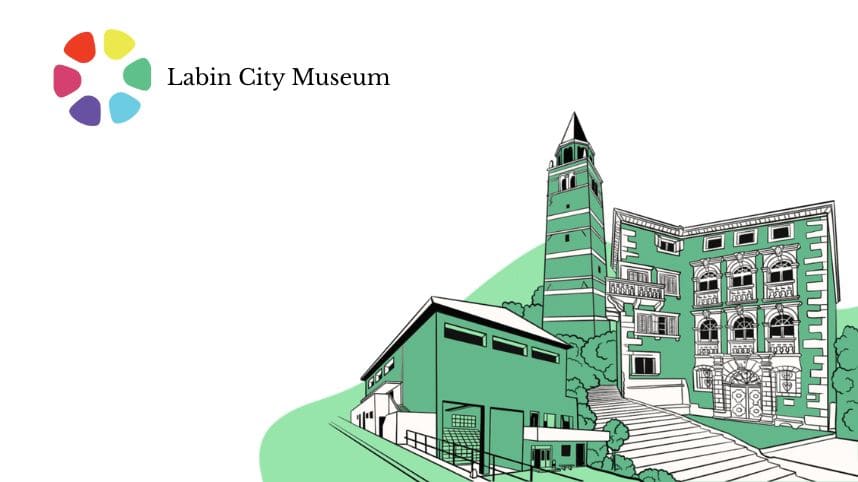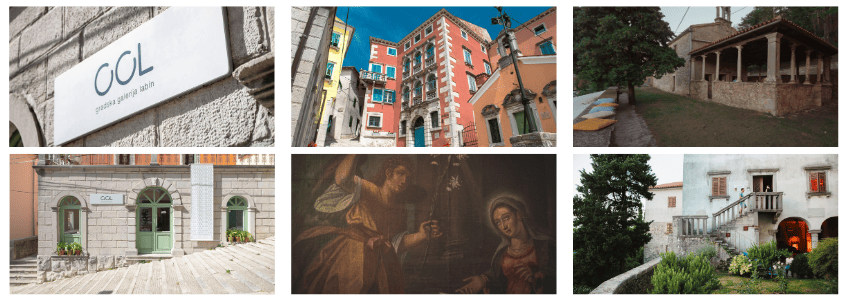Public Open University Labin
Public Open University Labin offers high-quality educational programs and cultural activities for all generations, promoting lifelong learning and community development.
Labin City Museum
The Labin City Museum is located in the old town core of Labin, within the Baroque Battiala–Lazzarini Palace, recognizable by its reddish facade with blue windows and its impressive size of nearly one thousand square meters. The palace was built around 1630, while its facade dates back to 1727. It served as the family residence of the Labin noble Battiala family until the 19th century, when, through the marriage of Margherita Battiala to Lodovico Lazzarini, the palace came under joint ownership of the Battiala–Lazzarini family.
City Gallery
The City Gallery Labin is part of the Public Open University Labin and functions as an exhibition space of the Labin City Museum.
It is located within the old town core of Labin in the former Luciani Palace, near the Parish Church of the Nativity of the Blessed Virgin Mary, opposite the Labin City Museum – Lazzarini-Battiala Palace, and the Chapel of St. Stephen. Over time, the palace underwent renovations and modifications. Besides its residential function, the ground floor was used for various commercial purposes (for some time also as a studio and exhibition space for the Labin artist Orlando Mohorović). From the original palace, only the portal with the coat of arms remains, featuring a stucco relief on the shield as a symbol of the Luciani family (Italian lucio = pike). Additionally, the architrave that once formed the entrance portal of the demolished rear part of the palace is now part of the permanent exhibition in the atrium of the Labin City Museum.
Exhibition activities in Labin initially (from the 1960s) took place in the gallery space for temporary exhibitions of the Labin City Museum. With the founding of the City Gallery at the end of 1999, Labin gained a dedicated space for the annual presentation of contemporary art.
The gallery began its operations with a ceremonial opening on December 30, 1999, featuring a reinterpretation of the exhibition “X. Labin Studios” – an informal group of Labin artists of various generations gathered around the Labin City Museum, originally held in that space in 1978. The founder of the gallery is the City of Labin, which at the time provided a public space without legal status for holding temporary exhibitions without a permanent collection. The gallery was managed by the City of Labin until 2011, when it was integrated into the Public Open University Labin, and more recently operates under the Labin City Museum.
The gallery primarily focuses on exhibiting works in diverse media of contemporary art, showcasing the creations of both established artists and younger generations active locally, nationally, and internationally. The selection of the exhibition program is carried out by the gallery curator and the Expert Council, whose members are elected for a four-year term. Annually, about ten solo and group exhibitions are organized.
Matija Vlačić Ilirik Memorial Collection
The Matija Vlačić Ilirik Memorial Exhibition was opened in 1975 on the occasion of the 400th anniversary of Vlačić’s death, in the former Francovich Palace, which is considered his birthplace. Matija Vlačić Ilirik, or Matthias Flacius Illyricus (Labin, 1520 – Frankfurt am Main, 1575), was a renowned reformer, theologian, church historian, and philosopher. He was born in Labin in 1520 and, at the age of sixteen, went to Venice for his education, where under the influence of his relative Baldo Lupetina he embraced Protestantism.
He spent most of his life in Germany as a professor of theology, Greek, and Hebrew, quickly becoming one of the close collaborators of the reformer Martin Luther. During his lifetime, he wrote over 200 books, pamphlets, and other works. His most significant works include Clavis Scripturae Sacrae (“Key to the Holy Scripture”), Catalogus Testium Veritatis (“Catalogue of the Witnesses of Truth”), and Ecclesiastica Historia (better known as the Magdeburg Centuries).
On the ground floor of the Francovich Palace, visitors can also view a lapidarium with medieval inscriptions and coats of arms. The collection on the life and work of Matija Vlačić Ilirik contains numerous historical, geopolitical, and religious insights from his era. Display cases feature copies of many of Vlačić’s works, with a particularly valuable exhibit being a copy of Vlačić’s portrait, created by Eugen Kokot after an original of an unknown author from the University Library in Jena.
Collection of Sacred Art
On the ascent to the old town of Labin stands a small church of the Brotherhood of St. Mary of Consolation, popularly known as St. Mary of Health, and today officially called the Church of the Assumption of Mary. The church was built in 1426, expanded in 1537, and received its current appearance in 1622 under the administration of Io(annes) Piera Klesar (Tagliapietra). His tomb, bearing a coat of arms, is located inside the church near the altar, along with about ten other tombs.
The marble Baroque altar, featuring a statue of the Virgin and Child dated 1697, was completed at the end of the 17th century. The church also houses a series of wooden statues depicting the apostles, which were once arranged as an iconostasis on the church’s partition, as well as a cycle of nine large oil paintings on canvas by Antonio Moreschi from the first half of the 17th century.
Together, these institutions and collections showcase Labin’s rich cultural, historical, and artistic heritage, offering visitors a unique journey through the town’s past and present.
For more information, visit us here.

